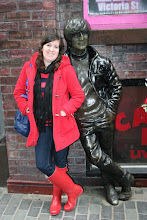Exactly one
year ago this weekend, I decided to attempt to cook my very first Thanksgiving
feast. Despite partaking in this annual tradition since I could eat solid food,
I have always been on the eating side of the meal, rather than constructing it
in the kitchen. That first attempt was a delicious success (if I do say so
myself) and I’m getting myself organized today to try to replicate it.
All of my
Thanksgivings growing up were a Canadian cliché (in the best possible meaning
of the word), from the food to the family to the location. For the latter, we
were either at my aunt and uncle’s house, surrounded by family, or at our
friends’, the Gibson’s, picturesque cottage, perched on an Ontario lake, as the
seasonal colours changed around us. Bottom line, it was pretty damn Canadian.
And the
food was always traditional as well. The usual fixings included: a massive
turkey, melting after hours in the oven; stuffing, which usual consisted of
bread, herbs and mushrooms, and cooked inside the cavity of the bird; roast
carrots, beets, parsnips and turnips; creamy mashed potatoes, whipped to
perfection; thick gravy to garnish all of the above; and, finally, both pumpkin
and apple pies, to suit any preference.
Yes, food
is a big part of Thanksgiving. But, equally, as is evident in the name, it is
about being with the people you love and sharing the things you are thankful
for. Over here in the UK, there is no equivalent to the North American
tradition. The nearest I can think of is the Sunday roast – a weekly staple for
some and a special treat for others – but it is not grounded in the same
customs as it is back home.
Brits often
ask me what Thanksgiving is all about. I usually give them a glib response:
eating turkey and pie, while getting your first three-day weekend after the
return to school. I know that’s not entirely true, but the history of the
harvest is honestly a bit of an afterthought for me.
So a quick
Wiki search brought up the following: The origin of the first Thanksgiving in
Canada goes back to the explorer Martin Frobisher, who had been trying to find
a northern passage to the Pacific Ocean. It was not celebrated as a harvest,
but in thanks for surviving the long journey from England. This was in 1578.
The origins can also be traced back to the French settlers who came to New
France with explorer Samuel de Champlain in the early 17th century. He also
took to celebrating successful harvests. As more settlers arrived in Canada,
more celebrations of a good harvest were common. In the US,
Thanksgiving also traces back to early settlers. The first celebration is
commonly recorded in 1621 at Plymouth in present-day Massachussets. It was also
prompted by a good harvest, as a way to feed all the colonists in an annual
festival.
The term
harvest carries with it visions of crops, fruitful at the end of the summer
season, and the stunning colours of autumn, the vermilions, garnets and golds
that blanket the foliage as the seasons change. It is also defined by the sun
spending less time in the sky, a crisp chill filling the air, and the glorious
crunch of newly fallen leaves under your feet.
London,
today, is demonstrating a few of these qualities; It is a blindingly sunny day,
though the air is noticeably cool, and, where greenery can be found, the
colours are turning to dark reds, oranges and yellows. This is one reason I’m
inspired to cook up a Thanksgiving meal tomorrow, but it is also the pang of
homesickness, the early October craving for turkey, and the desire to get my
hands dirty in my new kitchen.

